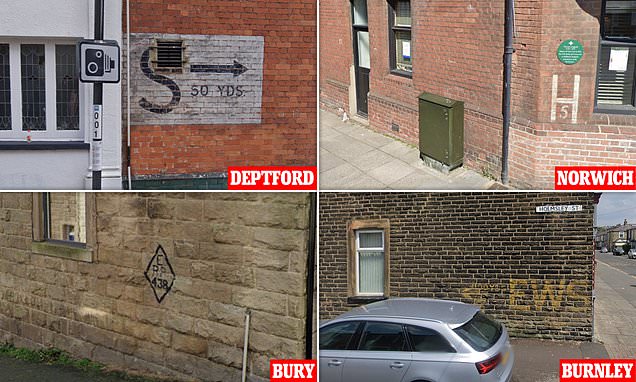From giant letters H and S to the curious ‘ERP’: The hundreds of fading signs dating back to WWII that exist around Britain – but do YOU know what they mean?
- The signs are explained in a Youtube video by historian Dr Mark Felton
From a giant H to the curious letters ‘ERP’, you may have wondered what fading signs spotted on buildings and streets around Britain represent.
Hundreds of the ghostly symbols exist on streets in London, Liverpool, Norwich and other major towns and cities.
Historian Mark Felton has revealed how they date back to the Second World War, when Britain was bombarded night after night by German bombs.
Signs showing the letter H once directed firemen to crucial hydrants that would have provided a water source when they were battling blazes caused by dropped explosives.
And the ERP sign, pictured in Lancashire, represents an ‘Emergency Rendezvous Point’ – where Britons could go to get help in the aftermath of a bombing raid.

A giant letter H is seen on a building in Wensum Street, Norwich. It dates back to the Second World War, when it pointed firemen to the locations of hydrants used to provide a water supply in the aftermath of a bombing raid

Two other shelter signs, this time in the form of a giant ‘S’ with an accompanying arrow, are emblazoned on walls just off Deptford High Street in East London. Above: One of the signs

During the Blitz, which began in 1940 and lasted until May 1941, more than 20,000 tonnes of explosives were dropped on 16 British cities. Above: A fireman carries a boy out of rubble after a bombing raid in London in 1940
The symbols have survived decades of regeneration and development, even as other tools in the fight against Hitler – such as air raid shelters and sirens – have long since disappeared.
In a recent video on his hugely popular Youtube channel, Dr Felton said: ‘The World War Two-era signage does linger on in our towns and cities, usually completely ignored by modern citizens.
‘But if you raise your head up from your smartphone and actually look, much does remain to be seen.’
He added: ‘The enormity of what all these surviving signs represented to the people of World War Two is very hard for those of us who didn’t live through the conflict to understand.
‘Put simply, they represented the difference between life and death; between saving your home and letting it burn down; between receiving essentials like water and medical assistance to being abandoned to pain and thirst.
‘So the next time you go for an urban walk, keep your eyes peeled, for you might just see a World War Two survivor, quietly fading away on a brick wall, forgotten, misunderstood but incredibly emotive.’
Other signs highlighted in his video include several in London pointing to air raid shelters.
Two are seen on the same property in a street in Westminster. The first reads: ‘Public shelters under pavements in this street.’
A second smaller sign then shows the letter S and bears an arrow pointing to a set of stairs leading to what is now the basement of the home.

This ERP sign, pictured in Bury, Lancashire, represents an ‘Emergency Rendezvous Point’ – where Britons could go to get help in the aftermath of a bombing raid

Two signs pointing to air raid shelters seen on the same property in Westminster. The first reads: ‘Public shelters under pavements in this street.’ A second smaller sign then shows the letter S and bears an arrow pointing to a set of stairs leading to what is now the basement of the home

In Liverpool, a sign pointing to the emergency exit for a former air raid shelter points to how the city suffered in the Blitz

Two fire hydrant signs are seen on this building in Upper King Street, Norwich. They would have been crucial when the city was bombarded between April and June in 1942 in what were known as the Baedeker Raids
The shelters would have been especially necessary during the Blitz, which began in 1940 and lasted until May 1941.
In that time, more than 20,000 tonnes of explosives were dropped on 16 British cities.
London was attacked 71 times and bombed by the Luftwaffe for 57 consecutive nights.
The City and the East End bore the brunt of the bombing in the capital with the course of the Thames being used to guide German bombers.
Londoners came to expect heavy raids during full-moon periods and these became known as ‘bombers’ moons’.
More than one million London houses were destroyed or damaged and of those who were killed in the bombing campaign, more than half of them were from London.

Another sign, in Burnley, bearing the letters EWS, once pointed Britons to an ’emergency water supply’, where they could get fresh water in the aftermath of a raid

Elsewhere in the capital, a faded sign to a gas decontamination centre exists in south-east London
Overall, more than 40,000 civilians lost their lives.
Two other shelter signs, this time in the form of a giant ‘S’ with an accompanying arrow, are emblazoned on walls just off Deptford High Street in East London.
Elsewhere in the capital, a faded sign to a gas decontamination centre exists in south-east London.
Britons would have gone there to get treatment in the event of a gas attack. Fortunately, no such raid ever took place.
Another sign, in Burnley, bearing the letters EWS, once pointed Britons to an ’emergency water supply’, where they could get fresh water in the aftermath of a raid.
In Liverpool, a sign pointing to the emergency exit for a former air raid shelter points to how the city suffered in the Blitz.

The Baedeker Raids destroyed many historic buildings and houses in Norwich, often causing blazes which were tackled by 15,000 fire guards

Liverpool was the most heavily bombed part of the country outside London, due to the existence of its port, which was crucial to the British war effort. Above: Part of Liverpool is seen in 1940 after a demolition squad had torn down buildings irreparably damaged by bombs
Liverpool was the most heavily bombed part of the country outside London, due to the existence of its port, which was crucial to the British war effort.
Between 1940 and 1942, more than 4,000 Liverpudlians lost their lives and tens of thousands of homes and businesses were destroyed.
The hydrant signs in Norwich would have been crucial when the city was bombarded between April and June in 1942 in what were known as the Baedeker Raids.
Ordered by Adolf Hitler himself, they targeted historic buildings in Norwich, Exeter, Bath, York and Canterbury in retaliation for an RAF attack on the medieval German city of Lubeck.
They got their name from a popular German guide book for Britain of the same name.
The Baedeker Raids destroyed many historic buildings and houses in the city centre, often causing blazes which were tackled by 15,000 fire guards.
More than 200 Norwich residents were killed in the 1942 raids alone, which also destroyed around 2,000 homes.
How the Blitz was the most intense bombing campaign Britain has ever seen – claiming more than 40,000 lives

A boy retrieves an item from a rubble-strewn street of East London after German bombing raids in the first month of the Blitz, September 1940
The Blitz began on September 7, 1940, and was the most intense bombing campaign Britain has ever seen.
Named after the German word ‘Blitzkrieg’, meaning lightning war, the Blitz claimed the lives of more than 40,000 civilians.
Between September 7, 1940, and May 21, 1941, there were major raids across the UK with more than 20,000 tonnes of explosives dropped on 16 British cities.
London was attacked 71 times and bombed by the Luftwaffe for 57 consecutive nights.
The City and the East End bore the brunt of the bombing in the capital with the course of the Thames being used to guide German bombers. Londoners came to expect heavy raids during full-moon periods and these became known as ‘bombers’moons’.
More than one million London houses were destroyed or damaged and of those who were killed in the bombing campaign, more than half of them were from London.
In addition to London’s streets, several other UK cities – targeted as hubs of the island’s industrial and military capabilities – were battered by Luftwaffe bombs including Glasgow, Liverpool, Plymouth, Cardiff, Belfast and Southampton and many more.
Deeply-buried shelters provided the most protection against a direct hit, although in 1939 the government refused to allow tube stations to be used as shelters so as not to interfere with commuter travel.
However, by the second week of heavy bombing in the Blitz the government relented and ordered the stations to be opened. Each day orderly lines of people queued until 4pm, when they were allowed to enter the stations.
Despite the blanket bombing of the capital, some landmarks remained intact – such as St Paul’s Cathedral, which was virtually unharmed, despite many buildings around it being reduced to rubble.
Hitler intended to demoralise Britain before launching an invasion using his naval and ground forces. The Blitz came to an end towards the end of May 1941, when Hitler set his sights on invading the Soviet Union.
Other UK cities which suffered during the Blitz included Coventry, where saw its medieval cathedral destroyed and a third of its houses made uninhabitable, while Liverpool and Merseyside was the most bombed area outside London.
There was also major bombing in Birmingham, where 53 people were killed in an arms works factory, and Bristol, where the Germans dropped 1,540 tons of high explosives and 12,500 incendiaries in one night – killing 207 people.
Source: Read Full Article


